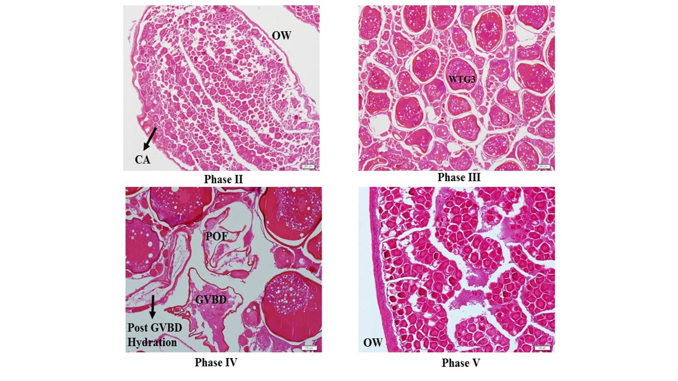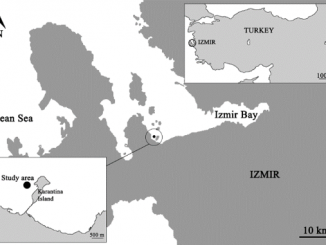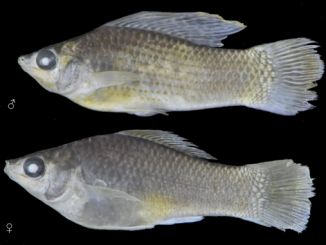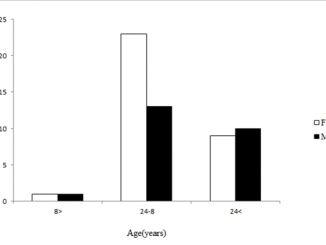
Paper category: Original research paper
Corresponding author: Abdullah Ekrem Kahraman (kahraman@istanbul.edu.tr)
DOI: 10.2478/oandhs-2021-0034
Received: 29/04/2021
Accepted: 02/07/2021
Full text: here
Citation (APA style): Kahraman,A.,Yıldız,T.,Uzer,U. & Çanak,Ö.(2021).Growth pattern, mortality and reproductive biology of common sole, Solea solea (Linneaus, 1758), in the Sea of Marmara, Turkey. Oceanological and Hydrobiological Studies,50(4) 398-410. https://doi.org/10.2478/oandhs-2021-0034
Abstract
The study deals with the growth pattern, mortality, and reproduction of common sole, Solea solea (Linneaus, 1758), from the Sea of Marmara (Turkey). A total of 580 fish specimens were sampled monthly from October 2017 to September 2018. The total length of all sampled individuals ranged from 11.1 to 29.5 cm, corresponding to ages from 1 to 3 years. The length–weight relationship was expressed as W = 0.022 TL2.6838, where the slope indicated negative allometric growth. Growth parameters were L∞ = 33.7 cm, k = 0.48, and t0 = −0.18 for all samples. A seasonally oscillating growth model, indicating the amplitude of oscillations, revealed an important seasonal growth pattern. Total, natural, and fishing mortality rates were calculated as 1.42, 0.47, and 1.01, respectively. The exploitation ratio (E = 0.68) indicates that the fishing pressure on the common sole in the Sea of Marmara was high. The sex ratio (♀/♂) was 1.18. The gonadosomatic index (GSI) for females showed that two main spawning seasons were observed: one in spring (May) and one in autumn (September–October). Sizes at the onset of sexual maturity were estimated for both females and males at 21.6 and 18.6 cm, respectively.
Conclusion
In the European Union, the minimum conservation reference size (MCRS) for common sole is 24 cm TL (EU 2019). In the current Turkish legislation, on the other hand, this size has been defined since 2006 as 20 cm TL (Yildiz & Ulman 2020b) and we consider that there is no scientific basis for this regulation. Furthermore, it can be concluded that different Lm sizes of common sole were calculated for different areas of Turkish waters. Regional fisheries management options should be considered to solve the regional differences based on scientific evidence. Therefore, we proposed that the MCRS for S. solea should be at least 22.0 cm to guarantee future generations of common sole in the Sea of Marmara. Fish catches below the MCRS must be discarded. Modifications to fishing gear and improvements in selectivity are likely to prove useful, e.g. the use of a larger mesh size for gillnets, the use of a square mesh panel or larger codend for beam trawlers.
A recent assessment study revealed that the common sole stock in the Aegean Sea is in poor condition and is overexploited regionally (Tsikliras et al. 2021). Moreover, a large-scale stock assessment study conducted in the Eastern Mediterranean Sea and the Black Sea showed a dramatic decline in commercial species (Demirel et al. 2020). The common sole has been listed in the IUCN Red List of Threatened Species under the “Data Deficient” category, and its subpopulations in the Mediterranean Sea have recently been assessed as “Least Concern” (Golani et al. 2011). However, common sole populations in the Sea of Marmara are overexploited and high fishing pressure on common sole, mainly from beam trawlers, can reduce the spawning stock biomass below levels sufficient for population productivity. The results of this study may contribute to better fisheries management for the common sole, as well as the entire region, and will then serve as a basis for further research.
Acknowledgements
We would like to acknowledge the funding provided for the project (No. 25915) by the Scientific Research Projects Unit of Istanbul University and to thank commercial and artisanal fishermen who helped us to collect fish samples. Finally, we greatly appreciate the reviewers’ valuable comments and the proofreader’s diligent efforts.
References
Anonymous (2001). Comparative data on fish life history. http://ifremer.fr/maerha/life_history.html
Bagenal, T.B. & Tesch, F.W. (1978). Age and growth. In T.B. Bagenal (Ed.), Methods for assessment of fish production in freshwater, 3rd edition (pp. 101–136). Blackwell Scientific Publication, Oxford, UK.
Basilone, G., Guisande, C., Patti, B., Mazzola, S., Cuttitta, A. et al. (2006). Effect of habitat conditions on reproduction of the European anchovy (Engraulis encrasicolus) in the Strait of Sicily. Fisheries Oceanography 15(4): 271–280. DOI: 10.1111/j.1365–2419.2005.00391.x.
Beverton, R.J.H. & Holt, S.J. (1959). A review of the lifespans and mortality rates of fish in nature, and their relation to growth and other physiological characteristics. In G.E.W. Wolstenholme & M. O'Connor (Eds.). CIBA Foundation colloquia on ageing: the lifespan of animals. Volume 5 (pp. 142–180). J & A Churchill Ltd, London.
Bilge, G., Yapici, S., Filiz, H. & Cerim, H. (2014). Weight–length relations for 103 fish species from the southern Aegean Sea, Turkey. Acta Ichthyologica et Piscatoria 44(3): 263–269. DOI: 10.3750/AIP2014.44.3.11.
Brown–Peterson, N.J., Wyanski, D.M., Saborido-Rey, F., Macewicz, B.J. & Lowerre–Barbieri, S.K. (2011). A Standardized Terminology for Describing Reproductive Development in Fishes. Marine and Coastal Fisheries: Dynamics, Management, and Ecosystem Science 3: 52–70. DOI: 10.1080/19425120.2011.555724.
Bök, T., Göktürk, D., Kahraman, A.E., Alicli, T.Z., Acun, T. et al. (2011). Length–weight relationships of 34 fish species from the Sea of Marmara, Turkey. Journal of Animal and Veterinary Advances 10: 3037–3042. DOI: 10.3923/javaa.2011.3037.3042.
Campillo, A. (1992). Les pêcheries françaises de Méditeranée: synthèse des connaissances. Institut Francais de Recherche pour l'Exploitation de la Mer, France. 206p.
Carpentier, A., Martin, C.S. & Vaz, S. (2009). Channel Habitat Atlas for Marine Resource Management (CHARM Phase II), INTERREG 3a Programme. IFREMER: Boulognesur–mer.
Cerim, H. (2017). Determination of Some Biological and Population Parameters of Common Sole (Solea solea Linnaeus, 1758) in Güllük Bay Trammel Net Fishery. Unpublished doctoral dissertation. Muğla Sıtkı Koçman University, Science Institute, Turkey. (In Turkish).
Cerim, H. & Ateş, C. (2019a). Mortality and exploitation of the common sole Solea solea (Linnaeus, 1758) from the trammel net fishery in southern Aegean Sea. Cahiers de Biologie Marine 60: 431–437. DOI: 10.21411/CBM.A.B8D19FF5.
Cerim, H. & Ateş, C. (2019b). Reproductive biology of female common sole, Solea solea (Linnaeus, 1758) in the southern Aegean Sea. Acta Biologica Turcica 32(3): 143–148. DOI: 10.26650/ASE2020596672.
Cerim, H. & Ateş, C. (2020). Age, growth and length–weight relations of common sole (Solea solea Linnaeus, 1758) from Southern Aegean Sea. Aquatic Sciences and Engineering 35(2): 36–42. DOI: 10.26650/ASE2020596672.
Colloca, F., Cardinale, M.F., Maynou, M., Giannoulaki, G., Scarcella, K. et al. (2013). Rebuilding Mediterranean fisheries: a new paradigm for ecological sustainability. Fish and Fisheries 14: 89–109. DOI: 10.1111/j.1467–2979.2011.00453.x.
Coull, K.A., Jermyn, A.S., Newton, A.W., Henderson, G.I. & Hall, W.B. (1989). Length–weight relationships for 88 species of fish encountered in the North Atlantic. Scottish Fisheries Research Report, 43, 80 p.
Crec'hriou, R., Neveu, R. & Lenfant, P. (2013). Length–weight relationship of main commercial fishes from the French Catalan coast. Journal of Applied Ichthyology 29: 1191–1192. DOI: 10.1111/j.1439–0426.2012.02030.x.
De Veen, J.F. (1976). On changes in some biological parameters in the North Sea sole (Solea solea L.). ICES Journal of Marine Science, 37, 60–90. DOI: 10.1093/icesjms/37.1.60.
Demirel, N., Zengin, M. & Ulman, A. (2020). First Large-Scale Eastern Mediterranean and Black Sea Stock Assessment Reveals a Dramatic Decline. Front. Mar. Sci. 21 February 2020. DOI: 10.3389/fmars.2020.00103.
Deniel, C. (1984). La reproduction des poissons plats (Téléostéens–Pleuronectiformes) en baie de Douarnenez. II. – cycles sexuels et fécondité des Soleidae: Solea vulgaris vulgaris, Solea lascaris, Buglossidium luteum et Microchirus variegatus. Cahiers de Biologie Marine, tome XXV, 257–285.
Deniel, C. (1990). Comparative study of growth of flatfishes on the west coast of Brittany. Journal of Fish Biology 37: 149–166. DOI: 10.1111/j.1095–8649.1990.tb05936.x.
Dorel, D. (1986). Poissons de l'Atlantique nord–est relations taille-poids. Institut Francais de Recherche pour l'Exploitation de la Mer. Nantes, France. 165 p. http://www.ifremer.fr/docelec/
Dulčić, J. & Glamuzina, B. (2006). Length–weight relationships for selected fish species from three eastern Adriatic estuarine systems (Croatia). Journal of Applied Ichthyology 22: 254–256. DOI: 10.1111/j.1439–0426.2006.00633.x.
Duncker, G. (1923). Korrelation zwischen Länge und Gewicht der Fische. Wissenschaftliche Meeresuntersuchungen Helgoland 15(4): 1–50.
El–Gammal, F.I., El-Etreby, S. & Sabrah, M.M. (1994). Estimation of mortality and yield per recruit of Solea solea (Linnaeus, 1758) in Lake Bardawil, Egypt. Bulletin of the National Institute of Oceanography and Fisheries 20: 175–184.
Ersönmez, H. & Özyurt, C.E. (2018). Determination of the reproductive period of S. solea and S. lascaris, which distributed in the Gulf of İskenderun. Ç.U. Institute of Natural and Applied Science. Journal of Science and Engineering 35: 39–78 (In Turkish).
EU (2019). Official Journal of the European Union. Regulation (EU) 2019/1241 of the European Parliament and of the Council of 20 June 2019.
Jennings, S., Reynolds, J.D. & Mills, S.C. (1998). Life history correlates of responses to fisheries exploitation. Proceedings of the Royal Society of London Series B 265: 333–339.
FAO (2020). Species Fact Sheets, FAO Rome Italy. http://fao.org/fishery/species/3367/en
GFCM (2020). The State of Mediterranean and Black Sea Fisheries 2020. General Fisheries Commission for the Mediterranean. Rome. DOI: 10.4060/cb2429en.
Follesa, M.C. & Carbonara, P. (2019). Atlas of the maturity stages of Mediterranean fishery resources. Studies and Reviews n. 99. Rome, FAO, 268 pp.
Froese, R. (2006). Cube law, condition factor and weight–length relationships: history, metaanalysis, and recommendations. Journal of Applied Ichthyology 22(4): 241–253. DOI: 10.1111/j.1439–0426.2006.00805.x.
Froese, R. & Sampang, A. (2013). Potential indicators and reference points for good environmental status of commercially exploited marine fishes and invertebrates in the German EEZ. http://oceanrep.geomar.de/22079/.
Froglia, C. & Giannetti, G. (1985). Growth of common sole Solea vulgaris Quensel in the Adriatic Sea (Osteichthyes, Soleidae). Rapports et procés-verbaux des réunions Commission internationale pour l’exploration scientifique de la Mer Méditerranée 29(8): 91–93.
Froglia, C. & Giannetti, G.F. (1986). Remarks on rings formation in otoliths of Solea vulgaris and other flatfishes from the Adriatic Sea. FAO Fisheries Report. 345: 121–122.
Girardin, M., Bensahla Talet, A., Campillo, A. & Chalabi, A. (1986). Evaluation of relative yield per recruit based on length frequency distribution. Application to three demersal species (Solea vulgaris, Phycis blennoides and Boops boops) of the western Mediterranean. FAO Fisheries Report. 347: 212–220 (In French).
Golani, D., Kada, O., Nouar, A., Quignard, J.P. & Cuttelod, A. (2011). Solea solea. The IUCN Red List of Threatened Species 2011: e.T198739A9091865. DOI: 10.2305/IUCN.UK.2015–4.RLTS.T198739A15595369.en.
Gökçe, G., Çekiç, M. & Filiz, H. (2010). Length–weight relationships of marine fishes off Yumurtalık Coast (İskenderun Bay), Turkey. Turkish Journal of Zoology, 34, 101–104. https://doi.org/10.3906/zoo-0905-33
Gulland, J.A. (1971). The fish resources of the oceans. West Byfleet, Surrey, Fishing News (Books), Ltd., for FAO, 255 p.
Hoşsucu, B. (1991). Investigations on bioecology and aquaculture potential of (Solea solea L., 1758) in the Gulf of İzmir. Unpublished doctoral dissertation. Ege University, İzmir, Turkey, 91 pp. (In Turkish).
Hoşsucu, B., Kaya, M. & Taşkavak, E. (1999). An investigation of growth parameters and otolith–total length relationship of Solea solea (L., 1758) (Pisces: Soleidae) in Izmir Bay. Israel Journal of Zoology 45: 277–287. DOI: 10.1080/00212210.1999.10688998.
ICES (2012). Report of the Working Group on the Assessment of Demersal Stocks in the North Sea and Skagerrak (WGNSSK), 27 April–03 May 2012, ICES Headquarters, Copenhagen. ICES CM 2012/ACON, 13, 1346 p.
Jennings, S., Reynolds, J.D. & Mills, S.C. (1998). Life history correlates of responses to fisheries exploitation. Proc R Soc London B 265: 333–339.
Kinacigil, H.T., İlkyaz, A.T., Metin, G., Ulaş, A., Soykan, O. et al. (2008). Determination of the length at first maturity, age and growth parameters of the demersal fish stocks in the Aegean Sea. TÜBİTAK Project No: 103Y132. (In Turkish).
King, M. (1995). Fisheries biology, assessment and management. Fishing News Books, Oxford, 341 pp.
Koutrakis, E.T. & Tsikliras, A.C. (2003). Length–weight relationships of fishes from three northern Aegean estuarine systems (Greece). Journal of Applied Ichthyology 19: 258–260. DOI: 10.1046/j.1439–0426.2003.00456.x.
Maci, S., Longo, E. & Basset, A. (2009). Length–weight relationships for 24 selected fish species from a non-tidal lagoon of the southern Adriatic Sea (Italy). Transitional Waters Bulletin 3(3): 1–9. DOI: 10.1285/i1825229Xv3n3p1.
Mahé, K., Bellamy, E., Delpech, J.P., Lazard, C., Salaun, M. et al. (2018). Evidence of a relationship between weight and total length of marine fish in the Northeastern Atlantic Ocean: physiological, spatial and temporal variations. Journal of the Marine Biological Association of the United Kingdom 98(3): 627–625. DOI: 10.1017/S0025315416001752.
Mehanna, S.F. & Salem, M. (2012). Fisheries regulations based on yield per recruit analysis for the common sole Solea solea (Soleidae) at Bardawil Lagoon, Mediterranean Coast of Sinai, Egypt. Egyptian Journal of Animal Production 49(1): 113–121. DOI: 10.21608/ejap.2012.94358.
Mehanna, S.F., Abo El–Regal, M. & Aid, N.M. (2015). Critical lengths, mortality rates and relative yield per recruit of the common sole Solea solea from the Egyptian Mediterranean Coast off Alexandria. Egyptian Journal of Aquatic Biology and Fisheries 19(2): 13–20. DOI: 10.12816/0016964.
Mendes, B., Fonseca, P. & Campos, A. (2004). Weight–length relationships for 46 fish species of the Portuguese west coast. Journal of Applied Ichthyology 20: 355–361. DOI: 10.1111/j.1439–0426.2004.00559.x.
Mildenberger, T.K., Taylor, M.H. & Wolff, M. (2017). TropFishR: an R package for fisheries analysis with length–frequency data. Methods in Ecology and Evolution 8: 1520–1527.
Muus, B.J. & Nielsen, J.G. (1999). Sea fish. Scandinavian Fishing Year Book, Hedehusene, Denmark. 340 p.
Newman, S.J. & Dunk, I.J. (2003). Age validation, growth, mortality, and additional population parameters of the goldband snapper (Pristipomoides multidens) off the Kimberley coast of northwestern Australia. Fishery Bulletin 101(1): 116–128.
Nielsen, E. (1972). The density dependent growth of sole (Solea solea). ICES CM 1972/F: 12.
Oral, M. (1996). An investigation on the biology of Sole (Solea vulgaris, Quensel, 1806) in the Sea of Marmara. Unpublished doctoral dissertation. İstanbul University, Turkey, 70pp. (In Turkish).
Pauly, D. & Munro, J.L. (1984). Once more on growth comparison in fish and invertebrates. Fishbyte 2(1): 21. http://pubs.iclarm.net/Naga/na_1951.pdf.
Piccinetti, C. & Giovanardi, O. (1984). Données biologiques sur Solea vulgaris Quensel en Adriatique. FAO Fisheries and Aquaculture Report 290: 117–121.
Quéro, J.C., Desoutter, M. & Lagardère, F. (1986). Soleidae. p. 1308–1324. In P.J.P. Whitehead, M.L. Bauchot, J.C. Hureau, J. Nielsen & E. Tortonese (Eds.). Fishes of the Northeastern Atlantic and the Mediterranean. UNESCO Paris, Vol 3.
Ramos, J. (1982). Estudio de la edad y crecimiento del lenguado, Solea solea (L, 1758) (Pisces, Soleidae). Investigación Pesquera 46(1): 15–28.
Reeve, A. (2007). Solea solea Sole. In H. Tyler–Walters & K. Hiscock (Eds.), Marine Life Information Network: Biology and Sensitivity Key Information Reviews. Plymouth: Marine Biological Association of the United Kingdom. Retrieved December 08, 2020, from: https://www.marlin.ac.uk/species/detail/2136.
Ricker, W.E. (1969). Effects of size–selective mortality and sampling bias on estimates of growth, mortality, production and yield. Journal of the Fisheries Research Board of Canada 26(3): 479–541. DOI: 10.1139/f69–051.
Ricker, W.E. (1973). Linear regressions in fishery research. Journal of the Fisheries Research Board of Canada 30(3): 409–434. DOI: 10.1139/f73–072.
Rijnsdorp, A.D. & Vethaak, A.D. (1997). Changes in reproductive parameters of North Sea plaice and sole between 1960 and 1995. ICES CMU 14, 31 p.
Saila, S.B., Recksiek, C.W. & Prager, M.H. (1988). Basic fishery science programs. A compendium of microcomputer programs and manual of operation. Developments in Aquaculture and Fisheries Science 18: 1–230. DOI: 10.1002/iroh.19900750115.
Siokou-Frangou, I., Christaki, U., Mazzocchi, M.G., Montresor, M., Ribera d’Alcalá, M. et al. (2009). Plankton in the open Mediterranean Sea: a review. Biogeosci Discuss. 6: 11187–11293.
Slastenenko, E. (1956). The fishes of the Black Sea basin. EBK press, İstanbul. (In Turkish).
Sparre, P. & Venema, S.C. (1992). Introduction to tropical fish stock assessment. Part I, Manual FAO Fish. Tech. Pap. No: 306/1, Rev 1, FAO, Rome.
Stergiou, K.I., Christou, E.D., Georgopoulous, D., Zenetos, A. & Souvermezoglou, C. (1997). The Hellenic seas: physics, chemistry, biology and fisheries. Oceanography and Marine Biology 35: 415–538.
Sümbüloğlu, K. & Sümbüloğlu, V. (2005). Biyostatistics (11. edition). Hatipoğlu press, Ankara, 270 p. (In Turkish).
Then, A.Y., Hoenig, J.M., Hall, N.G. & Hewitt, D.A. (2015). Evaluating the predictive performance of empirical estimators of natural mortality rate using information on over 200 fish species. ICES Journal of Marine Science 72(1): 82–92. DOI: 10.1093/icesjms/fsu136.
Torrejon–Magallanes, J. (2020). sizeMat: An R Package to Estimate Size at Sexual Maturity. https://cran.r–roject.org/web/packages/sizeMat/vignettes/sizeMat.html.
Tsikliras, A.C., Antonopoulou, E. & Stergiou, K.I. (2010). Spawning period of Mediterranean marine fishes. Rev. Fish. Biol. Fisheries 20: 499–538. DOI: 10.1007/s11160-010-9158-6.
Tsikliras, A.C., Touloumis, K., Pardalou, A., Adamidou, A., Keramidas, I. et al. (2021). Status and Exploitation of 74 Un–Assessed Demersal Fish and Invertebrate Stocks in the Aegean Sea (Greece) Using Abundance and Resilience. Front. Mar. Sci. DOI: 10.3389/fmars.2020.578601.
TÜİK (2020). Fisheries production statistics for 2019. Ankara, Turkey. Retrieved September 20, 2020, from www.tuik.gov.tr.
Türkmen, M. (2003). Investigation of some population parameters of common sole, Solea solea (L., 1758) from Iskenderun Bay. Turkish Journal of Veterinary and Animal Sciences 27: 317–323.
Vallisneri, M., Piccinetti, C., Stagni, A.M., Colombari, A. & Tinti, F. (2000). Population dynamics, growth and reproduction of Solea vulgaris (Quensel, 1806) in the upper Adriatic Sea. Biologia Marina Mediterranea 7: 101–106.
Veiga, P., Machado, D., Almeida, C., Bentes, L., Monteiro, P. et al. (2009). Weight–length relationships for 54 species of the Arade Estuary, southern Portugal. Journal of Applied Ichthyology 25: 493–496. DOI: 10.1111/j.1439–0426.2009.01230.x.
Vianet, R., Quignard, J.P. & Tomasini, J.A. (1989). Age et croissance de quatre poissons Pleuronectiformes (flet, turbot, barbue, sole) du golfe du Lion. Cybium 13(3): 247–258.
Von Bertalanffy, L. (1938). A quantitative theory of organic growth (Inquiries on growth Laws 2). Human Biology 10(2): 181–213.
Wurtz, M. & Matricardi, G. (2020). An attempt of growth parameter computation for some commercial species of the Tyrrhenian Sea. Rapports et procés–verbaux des réunions Commission internationale pour l’exploration scientifique de la Mer Méditerranée 30(2): 236.
Yildiz, T., Ulman, A. & Demirel, N. (2020a). A comparison of market landings during fish spawning seasons to better understand the effectiveness of the temporal fishery closure in Turkey. Ocean and Coastal Management 198. DOI: 10.1016/j.ocecoaman.2020.105353.
Yildiz, T. & Ulman, A. (2020b). Analyzing gaps in policy: Evaluation of the effectiveness of minimum landing size (MLS) regulations in Turkey. Marine Policy 115. DOI: 10.1016/j.marpol.2020.103829.
Zar, J.H. (1999). Biostatistical Analysis (4th ed.). Prentice-Hall Inc., New Jersey, pp. 662–663.



